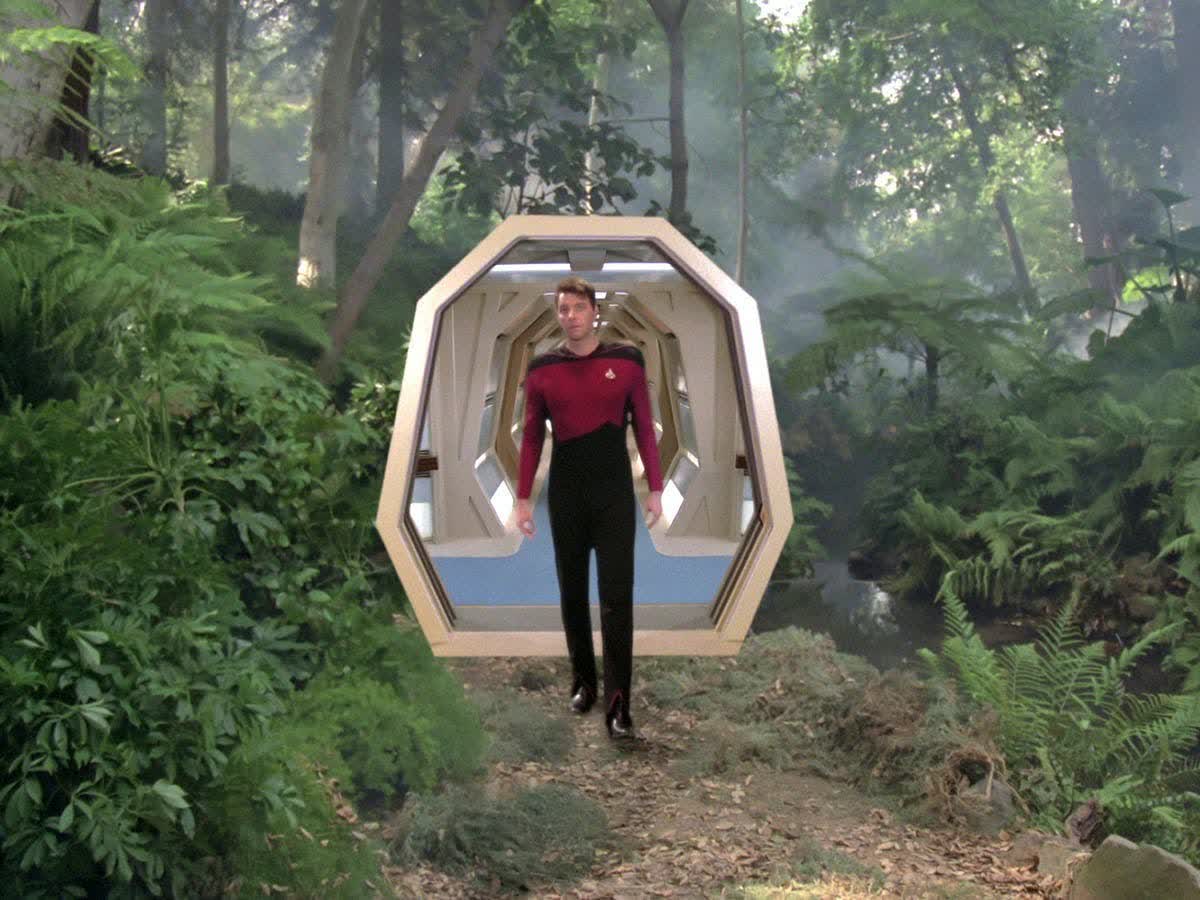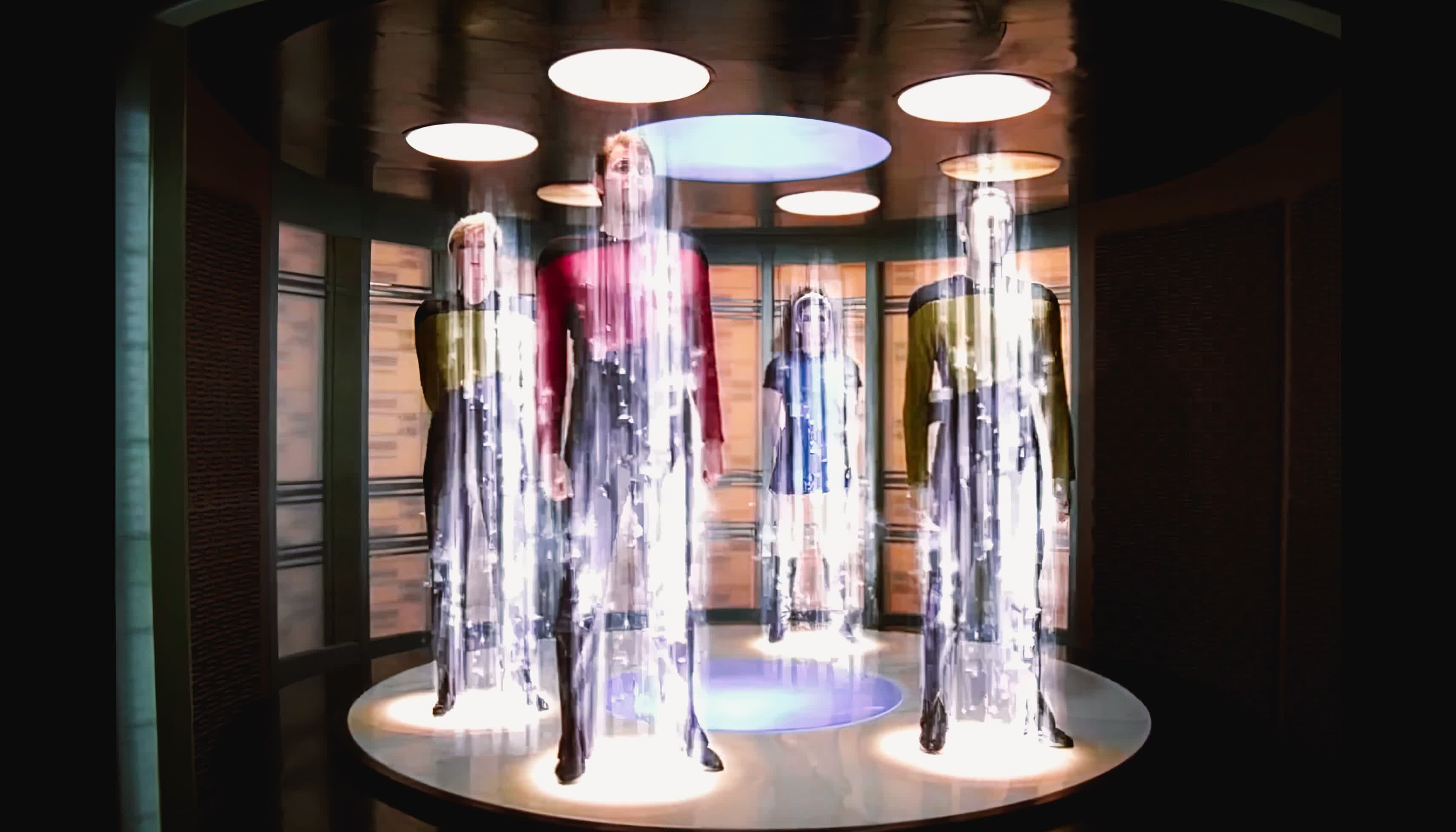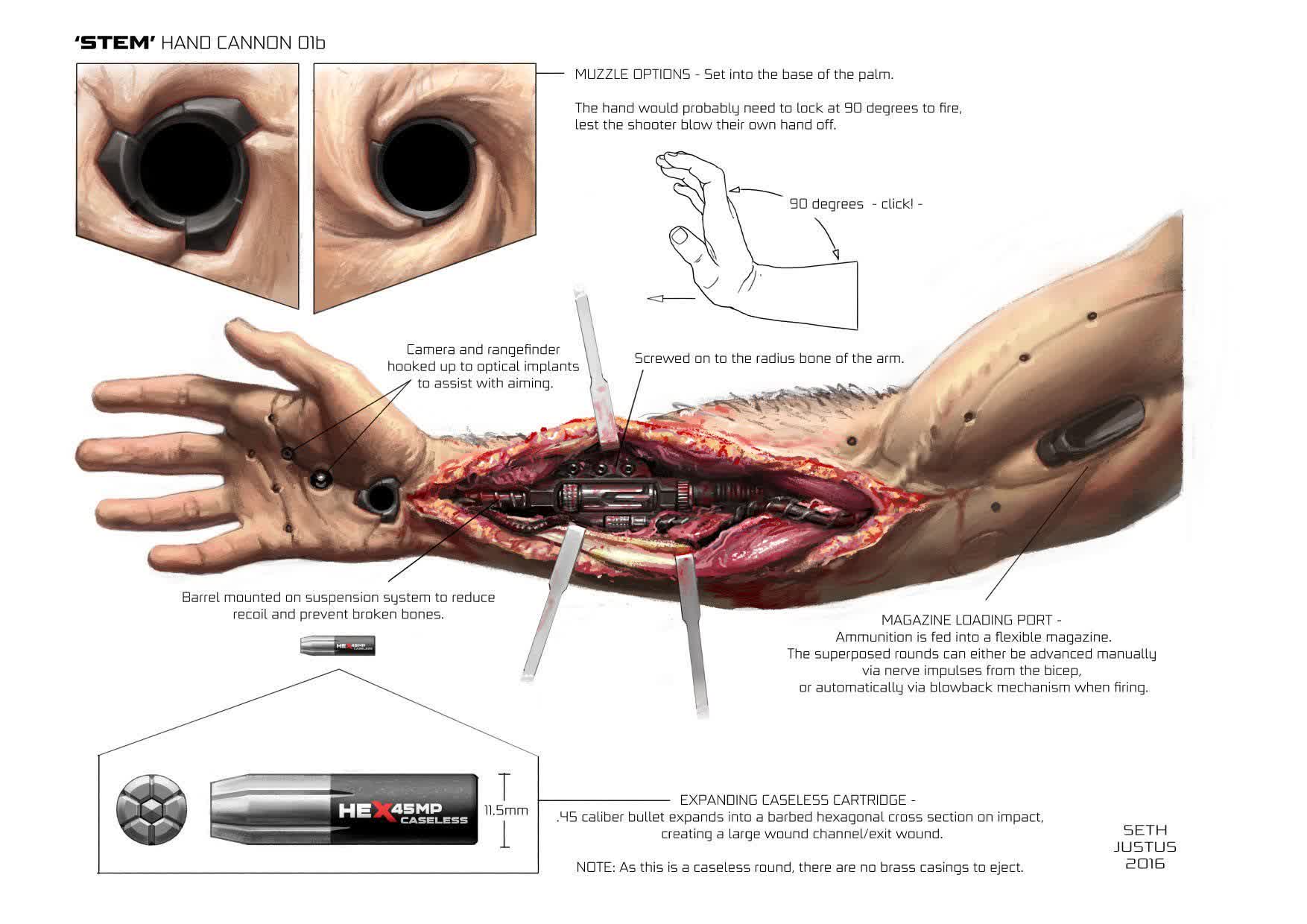Science fiction books, movies, games, TV shows and other media have long been home to amazing technology. Many of these ideas can serve as inspiration for today's scientists, but just how close are we to the real-life versions? In this feature, we look at ten of the best examples and rate the chances of their arrival within the next 30 years.
The Holodeck (Star Trek)
Here in the next 30 years? Score: 0/10

As Comic Book Guy from The Simpsons famously put it: "I'd like an hour on the holodeck with Seven of Nine." Futuristic virtual reality experiences appear in many works of fiction, though few are as well-known or fantastic as Star Trek's Holodeck.
While most people associate it with Star Trek: The Next Generation, the Holodeck's origins can be traced back to Fahrenheit 451 writer Ray Bradbury, who in his 1950 story "The Veldt" wrote about a virtual reality room able to reproduce anything a person can imagine. However, author Alexander Moszkowski may have been the first person to come up with such a concept.
The first Star Trek appearance was in a 1974 episode of the Star Trek: The Animated Series episode "The Practical Joker," long before it became a staple in Star Trek: TNG and appeared in other Trekkie franchises.
Sadly, a Star Trek-style Holodeck is pretty far from becoming a reality, to say the least. Advancements continue to be made in the fields of VR, AR, and holographic projection, but we're obviously nowhere near fully immersive rooms with solid projections featuring human-like AI. With its use of fictional transporter tech (see further down the list) and replicator systems, we might be waiting until the 24th century before going on virtual dates with former Borg drones.
KITT (Knight Rider)
Here in the next 30 years? Score: 5/10 (though some tech already exists)
Knight Rider is famous for two things: cementing Hoff's position as an icon in pop culture history, and the Knight Industries Two Thousand, better known as KITT. The modified 1982 Pontiac Trans-Am had a slew of abilities, most notably its amazing AI that was indistinguishable from human intelligence.
Artificial Intelligence has come an incredibly long way since the 1980s. With technology such as Google's Duplex, we're getting somewhat closer to an AI that can trick people into believing they're talking to another bag of blood and bones rather than complex code.
Looking at KITT's other tech: self-driving cars are now a reality, able to travel hundreds of miles with little to no human intervention, while Teslas have boasted a "summon" feature for years. Elsewhere, KITT can do 0 - 60 mph in 2 seconds, only a shade quicker than the Dodge Challenger SRT Demon; most cars have displays, touchscreens, even AR; we've also got vehicles with self-tinting windows. But not all of KITT's abilities have arrived---a retractable chemical analyzer tray and Passive Laser Restraint System still seem a way off.
Cortical Stacks (Altered Carbon)
Here in the next 30 years? Score: 0/10
Yes, the second season wasn't a patch on the first, but Netflix should face criminal charges for canceling Altered Carbon. The show was packed with awesome future tech, from synths and AIs to guns that can recall their fired rounds. But the highlight is the show's central theme: cortical stacks.
For the unfamiliar, a cortical stack is a vertebrae-shaped disk that can store a person's consciousness, allowing people to transfer their essence into new bodies, known as sleeves. Those who can afford it are essentially immortal, 'resleeving' whenever a current sleeve is about to expire, while the less fortunate have their stacks placed in storage facilities when a body dies. A person can exist pretty much indefinitely, as long as the stack is undamaged---though it is possible to store duplicate backups of a person, so they can be restored in the event of "real death."
In addition to the moral, ethical, and legal quagmires such technology would produce, being able to transfer human consciousness into artificial bodies remains the stuff of sci-fi. Back in 2015, a startup said it would be able to pull this off within the next 30 years, but it's been pretty quiet since then. Still, imagine how amazing it would be: if your body develops an incurable disease, just jump into a new one.
JARVIS (Marvel Universe)
Here in the next 30 years: Score: 6/10

Just A Rather Very Intelligent System, better known as Jarvis, is another artificial intelligence system that wouldn't find passing the Turing Test difficult. The AI is essentially more advanced, smarter, and human-like than KITT.
AI systems are becoming more like their movie equivalents all the time, able to fool humans into believing they're talking to a real person while performing tasks unimaginable 20 years ago. And voice-enabled smart assistants, while nowhere near Jarvis' level, have become prevalent. Will Alexa one day be considered the forerunner of an AI similar to Tony Stark's?
A real-life Jarvis would certainly be something special, but as Elon Musk likes to warn us repeatedly, unregulated advancements in the field of AI is humanity's "biggest existential threat" and "potentially more dangerous than nukes."
Jarvis also helped create the Iron Man Mark II suit, illustrating the AI's applications as a weapon. Killer robots have become a particularly hot topic in recent years, with more countries developing lethal autonomous weapons able to identify and engage targets without human intervention. Let's just hope one doesn't accidentally create Ultron.
Hand Terminals (The Expanse)
Here in the next 30 years? Score: 9.5/10

The expanse is another sci-fi show packed with cool tech, one of which is likely just around the corner: hand terminals. The devices might look like futuristic cell phones, but Ty Franck, co-writer of the novels and producer on the TV series, points out some important differences.
While both serve similar functions, the hand terminals are not powerful handheld computers but smart displays with little on-board processing power and memory. They link wirelessly with nearby smart devices and local computer networks, which do the heavy lifting.
Hand terminals work on a universal data protocol, allowing them to connect to local networks, be they in space, earth, or elsewhere. They recognize users, providing information based on the environment and that person's needs.
We've already seen transparent OLED displays in sliding glass doors and a concept television, so the technology is on the right track. Hand terminals also recognize hand gestures---like many current smartphones---that can be used to send information to other people or a TV. Mirroring a phone screen to a television is already possible, though the process isn't quite as smooth as it is with hand terminals. They also come in different sizes, much like smartphones and iPads.
While the full package isn't quite here yet, it seems almost certain that Expanse-style hand terminals, or something very similar, will be here in the next 30 years, if not sooner.
Flying cars (Back to the Future, The Jetsons, Futurama, etc.)
Here in the next 30 years? Score: 7/10

A controversial entry as many will argue that we already have flying cars, but most of these are small, roadworthy plane-like vehicles, or simply passenger-carrying large drones. What we want are the kind of flying cars seen in Back to the Future---essentially, ones that look like cars but can seamlessly take off and fly like a plane.
One of the closest working prototypes of a true flying car comes from Slovakian firm Klein Vision. Its fifth-generation AirCar could almost pass for a regular two-seater sports car, but a push of a button extends the tail and raises the wings. As long as there are around 300 meters of clear road ahead, drivers will be able to leave the earth for the air.
According to The Boston Consulting Group (BCG), a worst-case scenario would see 'just' 10,000 flying cars, including drone-like vehicles, in the air by 2030. If everything goes to plan, however, the company estimates a market of 60 million units, with a total of 825 billion flights. The group also believes that flying city-taxis will be the new normal by 2040. So, we might see Futurama-like skies full of cars in a couple of decades. "Welcome to the world of tomorrow."
Transporters / Teleporters (Star Trek)
Here in the next 30 years? Score: 0/10
Let's face it, a real-version of the transporters we see on Star Trek would have world-changing impact. Imagine being able to jump anywhere on earth, or even beyond our planet, in the blink of an eye. They would also have enormous implications for industries such as automotive, airlines, and oil, but those giants can breathe easily: it's extremely unlikely such technology could ever become a reality.
According to Star Trek, a transporter breaks a person into a "subatomically debonded matter stream" by destroying the bonds between individual atoms, then streaming them to a pattern buffer before being sent to the destination. The matter stream is reassembled back into the person once it arrives, the atoms reforming correctly through the use of a Heisenberg compensator.
Essentially, it sounds like rather than moving people from one place to another, transporters kill users before making identical copies elsewhere---though the franchise is pretty ambiguous about this, admittedly. If such technology ever did exist, it's hard to imagine many people would be willing to climb into one, no matter how convenient they might be.
Last year did see quantum teleportation achieved over ten miles of free space, though this is very different from sci-fi teleportation. The former involves entangling two particles so their states are dependent on one another, and each can be affected by the measurement of the other's state. The entanglement means that changing the state of one causes the other to change as well, allowing the teleportation of quantum information. Pretty amazing stuff, but don't ever expect to see people being beamed up IRL.
Gun implanted inside arm/hand (Upgrade)
Here in the next 30 years? Score: 4/10
The criminally underrated thriller/horror movie Upgrade features tons of imaginative tech, from super-advanced AI to nanobot-filled sneezes that can kill. But one of the movie's coolest and most talked-about elements is the gun that some bad guys have implanted in their arms/hands, which are fired by moving the hand to a 90-degree angle.
Implanted weapons are verging into Cyberpunk 2077 territory, though Upgrade shows them in a more practical, visceral way: caseless rounds are fed into a loading port located in the inner bicep; there are a camera and rangefinder in the palm that sends data to optical implants for aiming; and the equipment includes internal suspension systems to stop bones breaking when the gun's fired, which would be inconvenient.
While not in the same league tech-wise, last year saw the world's first implant-activated smart gun. It uses RFID so only those with the correct implant can fire it. Could this be a precursor to a full gun implant?
In addition to the technical barriers such as overheating, infections, and entire arms exploding, there are plenty of ethical and legal questions surrounding this sort of weapon. And doesn't having holes and cameras in your hand mean it's hardly a concealed weapon? Plus, there's the risk of accidentally blowing your head off when scratching your nose.
Time travel (Dr. Who, Back to the Future, Looper, etc.)
Here in the next 30 years? Score: 0/10

Is there anyone who wouldn't like the opportunity to go back in time? Be it for personal reasons or to benefit mankind, the idea of traveling to the past has captured the imagination for decades. But will such a thing ever be possible?
While there are studies on the use of quantum mechanics principles to travel huge distances without aging (relative time-travel), don't expect to see this in our lifetimes.
Traveling forward and backward in time, however, is a different story. There have been many theories put forward over the years claiming such a thing is impossible, no matter how technically advanced we become, and a new maths paper last year suggested the same thing.
As with everything in life, there are plenty of people who will argue against the evidence. Maybe the reason we've never discovered time travelers is that they go the extra length to disguise themselves; perhaps such a thing would be possible in certain regions of space; what about wormholes, assuming they exist? Either way, we're certainly not going to be jumping into our time-traveling DeLorean or Tardis within the next 30 years, sadly.
Invisibility cloak (Predator)
Here in the next 30 years? Score: 10/10
Invisibility cloak, in this context, refers to the kind sported by the Predators in the movie/comic franchise that bend light, not the magic-powered one loved by Harry Potter. Their use would completely change warfare---hiding soldiers from the enemy and even ground vehicles or buildings from aircraft. While the movies portray this amazing technology as the work of highly advanced aliens, such technology is close to being ready here on earth.
Rather than the impractical and imprecise method of using a camera to film something that's behind an object and projecting it onto the surface (much like the hallway scene in Mission: Impossible - Ghost Protocol), we have invisibility cloaks that work in the same way as the those belonging to mandible mawed Predators.
The tech uses metamaterials, which are metal-dielectric composites engineered on a nanoscale level. As per Interesting Engineering: "The composite structure acts as an array of artificial atoms, enabling electromagnetic radiation to pass freely around an object. The metamaterial guides light around the object it is coating to create the illusion that the object isn't there at all."
Canadian company HyperStealth Biotechnology Corp. made headlines in 2019 when it showed off a prototype invisibility material designed for the military (top video). Not only can it hide objects from the eye, but it also conceals them from infrared and ultraviolet imagers.
There's still more work to do; the fact that current prototypes don't make something completely invisible being the biggest hurdle. But don't be surprised to see them become a standard part of a soldier's equipment by 2051.
What favorite fictional tech are you hoping will arrive in the next 30 years?


